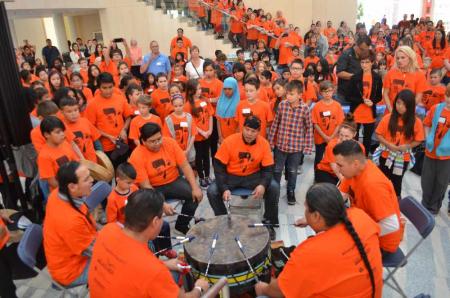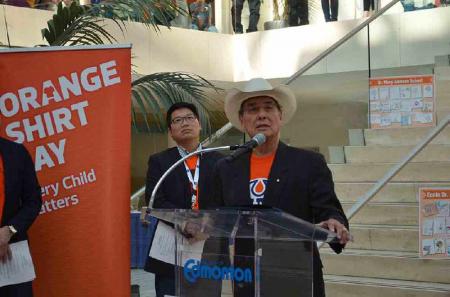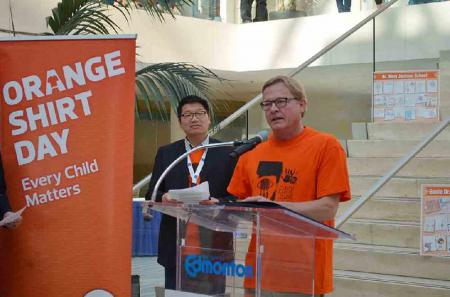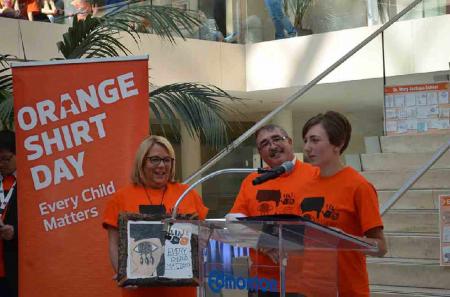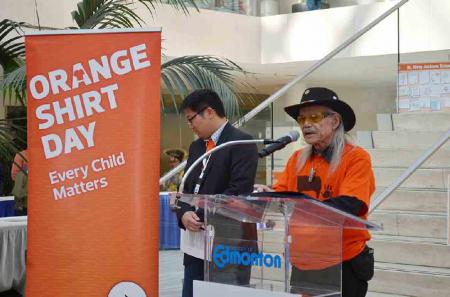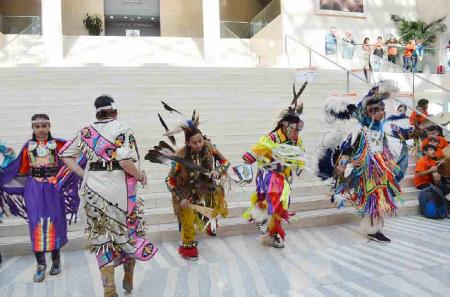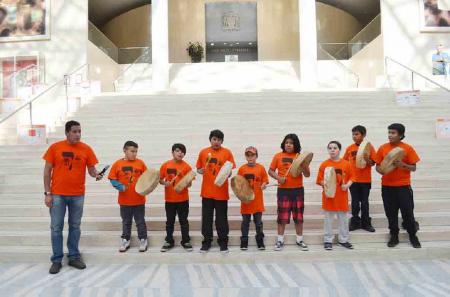Summary
{ALBUM_998719}
By Paula E. Kirman
Windspeaker.com Contributor
EDMONTON
Hundreds of students, politicians, dignitaries, and members of the public took part in Orange Shirt Day. Edmonton’s City Hall was filled with a sea of orange shirts on Sept. 29. Officially, Orange Shirt Day is recognized on Sept. 30, but the event is commemorated on days leading up to Sept. 30 as well.
Those in attendance confronted the history of the residential school system, while looking towards the future with a spirit of reconciliation.
Dr. Wilton Littlechild, grand chief of the Confederation of Treaty 6 First Nations, acknowledged the children and youth in the audience.
“I am reminded that for many years I was your age and probably your size in three different residential schools for 14 years,” he said. Littlechild was one of the three commissioners of the Truth and Reconciliation Commission.
“It's not just a shirt that commemorates this moment, but also years and years of very difficult history where young people were taken from their families, their language and culture. Those most important things that make you a person,” said Hon. David Eggen, Minister of Education.
“At the same time it's a chance to move positively into the future. You can't move positively into the future until you know your past.”
Another residential school survivor, Métis Elder Terry Lusty recited a poem he wrote as part of a book of poetry about his experiences. He also noted the children in the audience and cited the importance of a proper education.
“When I was in residential schools for eight years, one of the things we faced very seriously was a lack of proper education. You children are so fortunate in the world we live in today, with the subject areas you are able to take in school and learn and grow from, things that will prepare you for your future because you are leaders of tomorrow.”
Lusty is a well-known writer, teacher and photographer. An exhibit of his photographs dealing with reconciliation was at City Hall for Orange Shirt Day. In a very emotional moment, he made a special presentation to Gisele Wood, the widow of Elder Jerry Wood, who passed away last year. Wood was the Elder in Residence with Edmonton Catholic Schools.
The event also featured a drum circle, dance performances by students from Edmonton Public, and a song in Cree from students at Enoch.
Orange Shirt Day started in Williams Lake, B.C. in 2013 as a way of remembering the victims and impact of residential schools. The event gets its name from a story about a six-year-old girl who was a student at the St. Joseph Mission. On her first day of school, she had her new, beloved orange shirt taken away from her.
In Edmonton, the event was organized by the Society for Safe and Caring Schools and Communities, a non-profit that seeks to improve the quality of Life for All Alberta children in such ways as addressing issues of bullying and violence.
Gallery
Windspeaker.com is owned and operated by the Aboriginal Multi-Media Society of Alberta, an Aboriginal communications society dedicated to serving the news and information needs of Aboriginal people throughout Canada.
Incorporated in 1983 under the Alberta Societies Act, the Aboriginal Multi-Media Society has steadfastly maintained its commitment to the quality of its products and its people.
AMMSA has served as the model for Aboriginal communications societies and organizations and has provided training, support, and encouragement to other Aboriginal groups, communities, and societies wishing to establish their own communications facilities.
Our Mission:
The Aboriginal Multi-Media Society is an independent Aboriginal communications organization committed to facilitating the exchange of information reflecting Aboriginal culture to a growing and diverse audience.
AMMSA is dedicated to providing objective, mature and balanced coverage of news, information and entertainment relevant to Aboriginal issues and peoples while maintaining profound respect for the values, principles and traditions of Aboriginal people.
Organizational History
1983
A monthly publication was first published in 1983, Windspeaker was intended to serve the Aboriginal people of northern Alberta. In the years that followed, Windspeaker expanded and developed its circulation base and readership to the point where in 1993, on its 10th anniversary, it refocused its editorial coverage and repositioned itself to become Canada's first and only provider of national Aboriginal news, information and opinion. It was a tremendous leap of faith and required a substantial shift in strategy and a major realignment of critical resources.
1990
With a 100 per cent cut in federal funding in 1990, nine of the 11 Aboriginal publications across Canada included in the now defunct Native Communications Program closed their doors. Windspeaker was the only publication west of Ontario to survive the federal cuts and was challenged to fill the void created by the demise of these other publications.
1993
"This was an excellent window of opportunity for us, and Windspeaker took up the challenge. Our goal was to provide news, information and views from a national perspective in a way that would complement the work of other Aboriginal media, which typically served a much more local community," said Bert Crowfoot, Windspeaker publisher.
"Back in 1993 we put our faith in our staff to transform Windspeaker into a national forum that would be supported by readers through subscriptions and, in time, by advertisers. "
The formula has worked very well. After years of cost-cutting with the elimination of government funding, AMMSA and Windspeaker are underwent expansion and growth.
"One of our organization's philosophies is to turn stumbling blocks into stepping stones. We saw the elimination of government funding, both provincial and federal, as a wake-up call to pursue the dream of having an Aboriginal publication that was both financially and politically independent. We focused on developing a product that would attract a loyal readership," said Crowfoot.
1996
AMMSA launches debuts its first website property: www.ammsa.com
2000
AMMSA digitizes all of the published articles in Windspeaker and its publication Alberta Sweetgrass, launched in December 1993, dating back to 1983 and makes them available online as part of a archive of 20,000+ news and information articles.
AMMSA also owns and operates CFWE-FM radio, Alberta's first and most extensive Aboriginal broadcaster.
Currently serving 54 Alberta Aboriginal communities via satellite, an extensive and ambitious expansion plan has been developed to broadcast CFWE throughout southern Alberta.
As we continue to increase the signal coverage area, our plan is to include every First Nation and Métis Settlement in Alberta.
2009
CFWE radio launches in urban centres: Edmonton and Fort McMurray.
The Future
Not an organization to shy away from new technology, AMMSA has also developed comprehensive web site properties to showcase its various services, publications, news and entertainment online, including Windspeaker.com and cfweradio.ca


